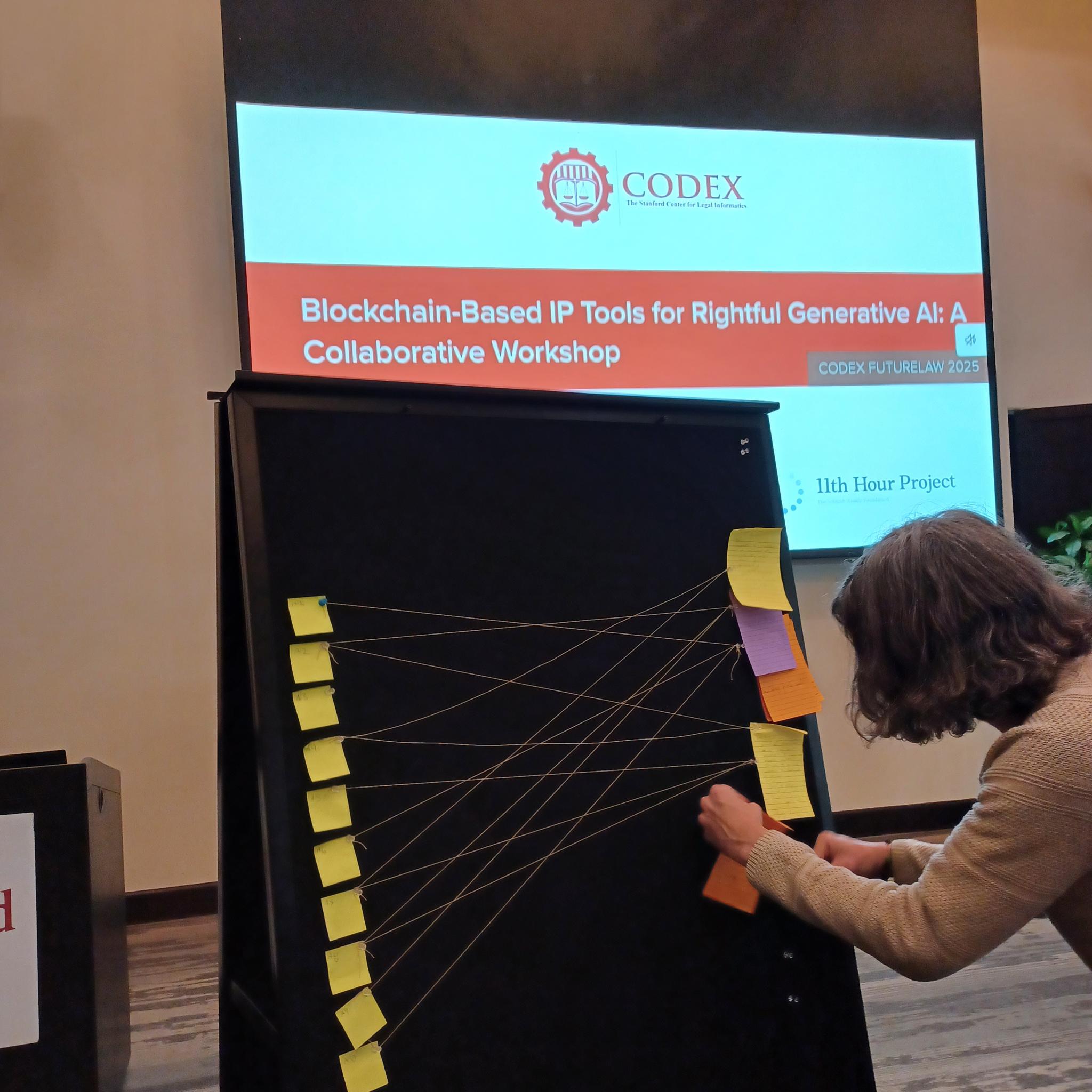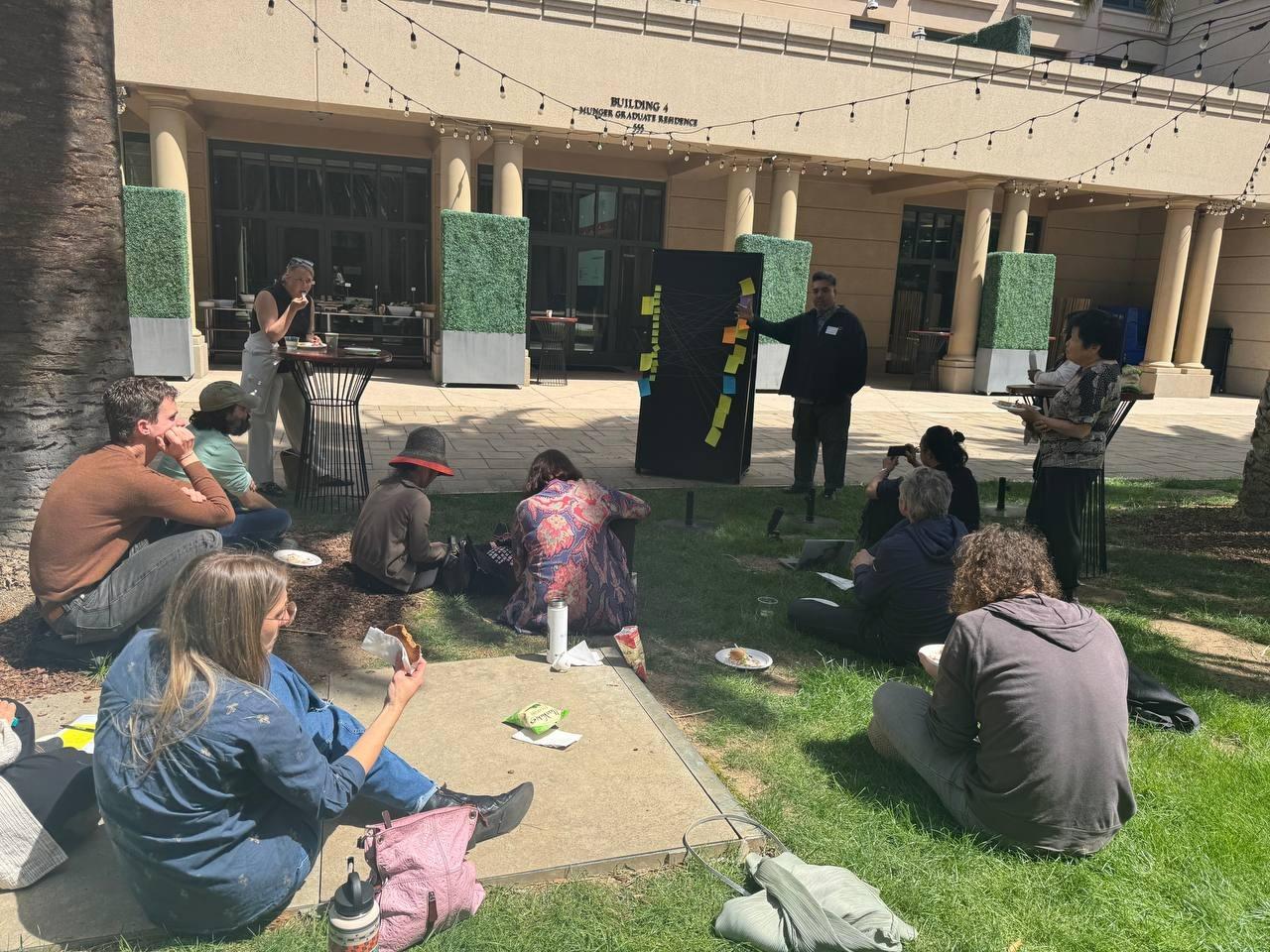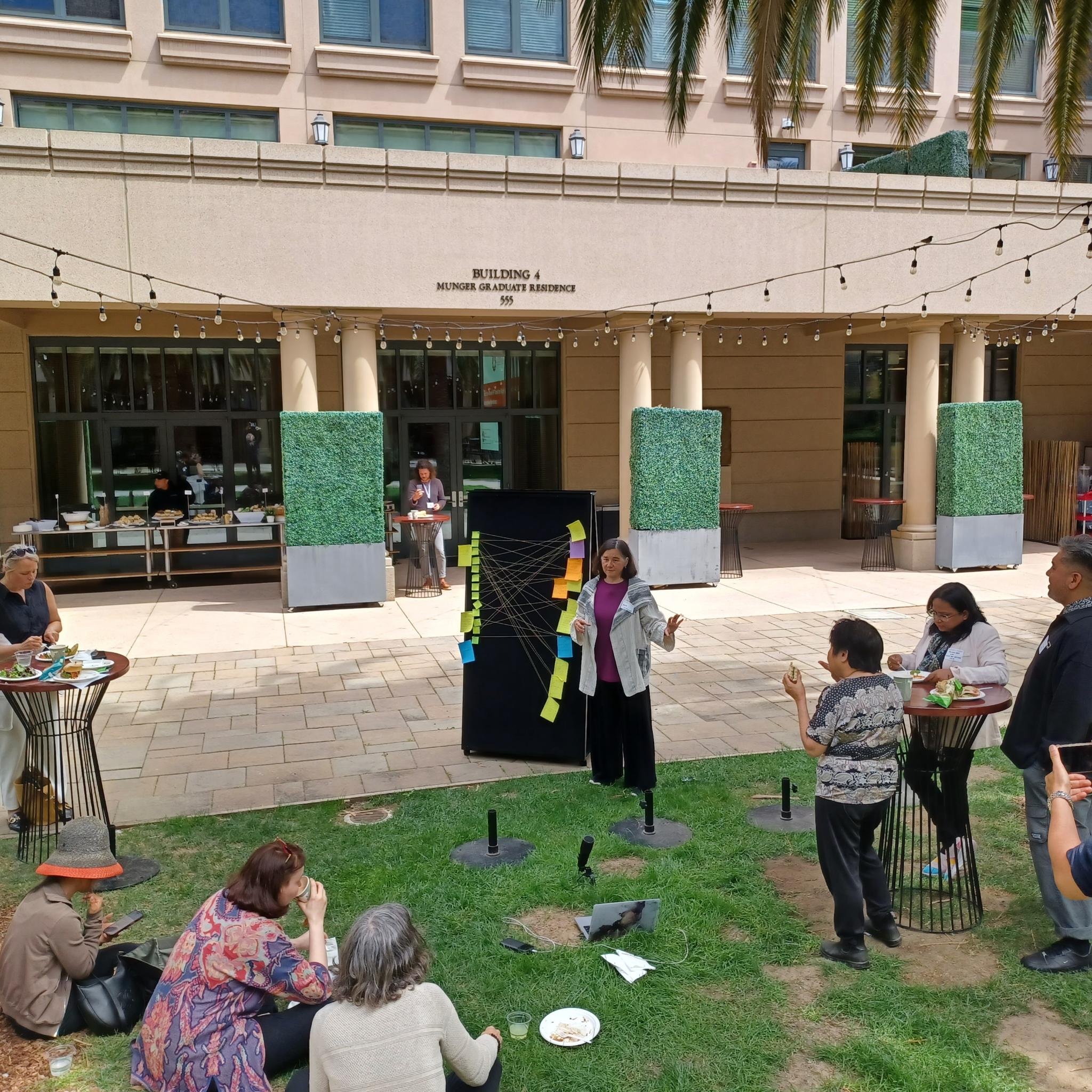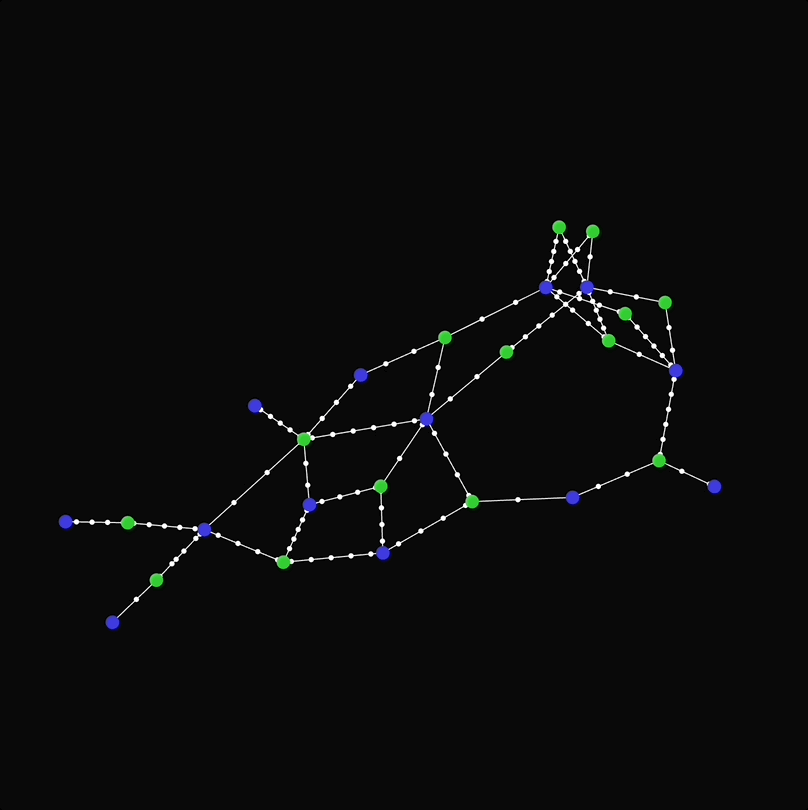Overview of game
Polycentric is a role-playing game of agreements. Players engage in open exploration through agreement space, with resources available not constrained to capital. Players assume Roles, which have a set of Values, Goals, Resources, Obligations, etc. There is no set victory condition for the game, so there is less of a need to restrain the solution space (admissable action) of the players. The fitness function for players in the state of play is to:
- openly imagine and explore new forms of agreements typically restricted by ontological and material constraints
- improve understanding of a role through experience negotiating/feeling through its available agreement space
- improve understanding of a network and its available agreement space
Session Zero
Though we hadn’t even played the game ourselves yet, we thought it wise to run our first play test session in the wild at Stanford CODEX’s annual gathering of Law, AI, systems thinkers hosted by the respectable Tony Lai.
Setup (30 mins)
Z explained the game overview and basic rule set. Players Dorn described the Scenario. The roles were based on an actual convening, Grassroots Innovation Assembly. Distributed roles to players. Ven prepared the Board of Agreements and data visualization of agreements as a bipartite graph. So players can see agreements being made as a network.
Play time (60 mins)
Players familarized themselves with their roles in relation to the scenario, and then made a quick introduction of their role to the group.
We then basically said ‘Play’, merely instructing them to start talking with each other to discover and build agreeements. Some players began negotiating with their neighbors. Most moved around, bouncing from negotiation to negotiation. Many pods of agreement-forming activity could be seen, with agents flowing in and out between them.
As agreements were made, players would write down which agents were involved the agreement and the terms of the agreement. Listing the obligations that were given, and the benefits received. They would then tack the agreement on on the right side of the board and then connect it with string to all involved agents from the left side of the board.

The first agreement was a small MOU style agreement between a global policy advocator and indigenous practitioner to hold space together and learn from each other.
The second to last agreement was a complex multilateral agreement. A coalition formed of 5 developer-related roles, adding a new agent to the board, which then formed another bilateral agreeement with another agent for the final agreement before lunch.
Debrief (30 mins)
Players were having a great time playing the game, so play continued through lunch, where we did a collective debrief of agreements made. For each agreement, a player who participated would come up and share the dynamics of the agreement. Which agents were involved, to what degree, and the purpose or benefits of the agreement.


Observations Notes from Session Zero
data visualization
 bipartite network graph of agents (blue) and agreements made (green).
bipartite network graph of agents (blue) and agreements made (green).
modes of play observed
Players embodied their roles extremely well. Though there was variance in how they embodied their roles. Some more emotional and others more strategic and calculated.
Session Zero Agreements
types of agreements made
- bilateral symmetric
- multilateral asymmetric
- formation of coalition as new agent
AG1 — Soil Data Sharing Cooperative
Summary: A cooperative framework where members contribute soil samples or agricultural data for collective analysis and shared insights.
Parties: A1, A2, A5
Obligations:
- A1, A2, A5: Provide consistent data inputs (e.g., crop types, soil samples, yield logs)
- A4 (Coordinator): Analyze data and return comparative reports
Benefits:
- A1, A2, A5: Access to aggregated data for better decision-making
- A4: Ground-truth data for research or product development
AG2 — Seed Exchange Network
Summary: Agreement around sharing and exchanging seed varieties among smallholder farmers.
Parties: A1, A3, A6
Obligations:
- Each participant: Contribute at least one unique or adapted seed variety and document results
Benefits: - All: Increased biodiversity and access to local seed knowledge
AG3 — Social Climate Adaptation Circle
Summary: A support-oriented agreement for knowledge exchange on social and ecological resilience practices.
Parties: A7, A8, A9
Obligations:
- Members: Share practices or stories about climate adaptation
- Host (A7): Document and circulate key learnings
Benefits: - All: Shared resilience strategies, emotional and practical support
AG4 — Resource Lending Network
Summary: Pooling of physical tools or equipment among farmers to reduce individual costs.
Parties: A2, A3, A5
Obligations:
- Lenders (A2, A3): Maintain tools, define borrowing terms
- Borrowers (A5): Return tools, offer labor or services
Benefits: - Lenders: Social capital, non-monetary returns
- Borrowers: Access to tools they can’t afford
AG5 — Knowledge Commons Assembly
Summary: Collaborative documentation and open sharing of agroecological practices and local innovations.
Parties: A4, A6, A9
Obligations:
- Each member: Contribute documented method or case
- A4: Maintain open access archive
Benefits: - Contributors: Visibility, feedback
- Community: Free access to vetted knowledge
AG6 — Agroecology Mentorship Chain
Summary: A cascading mentorship system to pass knowledge through generational tiers.
Parties: A1, A4, A6
Obligations:
- Seniors (A1, A4): Provide mentorship
- Juniors (A6): Apply learnings and mentor others
Benefits: - Seniors: Legacy, recognition
- Juniors: Credibility, deep knowledge access
AG7 — Climate Tool Trial
Summary: Partnership to pilot a forecasting tool in exchange for field feedback.
Parties: A3, A4, A8
Obligations:
- A3, A8: Field test tool, provide feedback
- A4: Deliver updates, integrate insights
Benefits: - Farmers: Climate planning support
- Developer: Validation and case studies
AG8 — Mobile Market Access
Summary: Coordinated transport network for reaching urban markets.
Parties: A2, A5, A6
Obligations:
- Farmers: Sync harvests, pay fee or share fuel
- Coordinators: Maintain logistics and vehicles
Benefits: - Farmers: Better market access and prices
- Coordinators: Stable revenue, social value
AG9 — Data Commons Guild
Summary: Shared framework for managing agricultural data as a commons.
Parties: A1, A2, A4, A9
Obligations:
- Farmers: Monthly data contributions
- Stewards (A4): Secure and curate data
- Researchers (A9): Share outcomes and respect permissions
Benefits: - Farmers: Bargaining leverage
- Researchers: High-integrity datasets
AG10 — Rainwater Harvesting Circle
Summary: Mutual aid system for rain capture infrastructure.
Parties: A2, A3, A5, A6
Obligations:
- All: Build, maintain, and share repair knowledge
Benefits: - All: Water security, shared labor economy
AG11 — Intercrop Innovation Pact
Summary: Collaboration to test intercropping combinations across farms.
Parties: A1, A4, A7
Obligations:
- Farmers (A1, A7): Dedicate plots, share data
- Agronomists (A4): Share methods, analyze results
Benefits: - Farmers: Yield optimization
- Researchers: Field results
AG12 — Storytelling for Policy Change
Summary: Stories from food systems to influence policy.
Parties: A1, A6, A10
Obligations:
- Farmers (A1, A6): Provide narratives
- Advocates (A10): Convert stories into briefs
Benefits: - Farmers: Policy influence
- Advocates: Grounded, compelling material
AG13 — Collective Carbon Commons
Summary: Agroforestry-linked carbon credit initiative.
Parties: A5, A8, A11
Obligations:
- Stewards (A5): Follow protocols
- Verifiers (A8): Certify outcomes
- Funders (A11): Share carbon returns
Benefits: - Stewards: Carbon revenue
- Verifiers: Publishable results
- Funders: Reputational and ROI gains